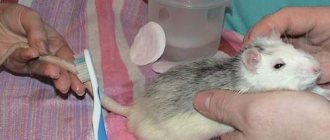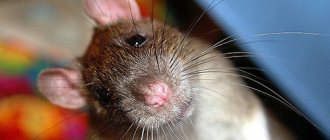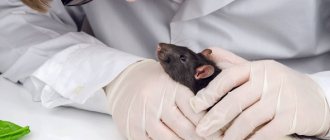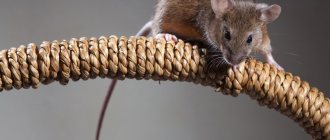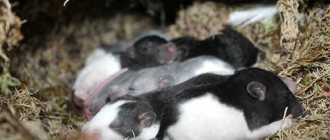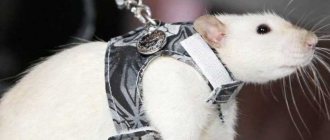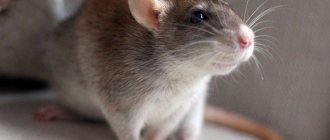Symptoms
- Swellings with purulent contents form on the skin.
- The skin at the site of the abscess becomes thinner and peeling is noted;
- The animal refuses to eat, its behavior changes - the animal loses activity and does not show interest in anything.
Invaded bacteria and infections begin to actively grow, which is why a “capsule” is formed around the abscess itself, which prevents the spread of pathogenic bacteria to neighboring tissues.
Hyperemic (reddened) segments may appear on the skin, which subsequently become denser; the last stage of development of the disease is the formation of an abscess with purulent contents, this place is soft to the touch.
An abscess can develop in different ways:
- if the animal’s immunity is strong enough, the body is able to overcome the formation of pus and destroys all bacteria and infections inside the capsule;
- the formation of an abscess above the level of the skin, and not inside the tissues, as a result of which the thinned skin is opened, the purulent contents come out and healing occurs;
- an abscess forms inside the tissues, spreading inward, nearby vessels carry pathogenic bacteria throughout the body, and sepsis develops.
Chronic respiratory syndrome (mycoplasmosis) of rats and other mouse-like rodents
It is not news to lovers of decorative rodents that the most common disease of internal organs in rats (besides oncology) is diseases of the respiratory system. In veterinary medicine, diseases of the respiratory system of rats (and other mouse-like rodents close to them - various types of ornamental mice, gerbils) are referred to as chronic respiratory syndrome of mouse-like rodents (CRS) . This disease is often called mycoplasmosis (after the name of one of the causative agents of the disease, mycoplasma pulmonis). Features of rat physiology. - The average lifespan of rats is 1.5-2.5 years. Some “long-livers” live up to 3-3.5 years. Rats that are 5 or 7 years old are a myth. — rats are conventionally considered “middle-aged” after they reach the age of 1 year. Chronic respiratory syndrome is a disease of rats of all ages (but mainly older than 1 year), caused by a group of pathogens (mycoplasma, bordetella, pasteurella, streptococcus, sendai virus), manifested by respiratory (breathing disorders) and other symptoms (the reproductive system may be involved in the pathological process , skin, hearing organs, vestibular apparatus). It is believed that rats are lifelong carriers of these pathogens, primarily mycoplasma (microorganisms “live” on the mucous membrane of the respiratory tract of apparently healthy animals). The cause of the development of the disease is a variety of environmental factors and the state of the body (primarily the immune system) of a particular rat. When conditions favorable for microorganisms arise, their numbers sharply increase and spread throughout the rat’s body, which leads to a deterioration in the pet’s condition and the development of pronounced clinical signs. It is believed that it is impossible to completely cure a rat from CRS (mycoplasmosis). Therefore, the actions of a veterinary specialist are aimed at eliminating the identified clinical symptoms of the disease and restoring the comfort of the animal’s life.
Altered rabbit molars
The main symptoms of CRS: Respiratory form - lethargy and loss of appetite. - shortness of breath and sounds when breathing. - discharge from the eyes and nasal passages of the red pigment of the Harderian gland - porphyrin (usually they say that the rat has “porphyrinitis”). - sneezing. Other forms of the course that usually accompany the respiratory one: Skin – itching, scratching, sores and crusts on the skin. This condition is caused by the toxic effect of a rapidly increasing colony of pathogen (mainly mycoplasma) on the body. This condition should be distinguished from other skin diseases accompanied by itching (primarily mite infestation). Damage to the middle/inner ear and vestibular apparatus is characterized by a violation of the position of the head (tilt to the right or left) and/or impaired coordination of the animal up to a complete loss of support on the limbs, forced posture and rotational movements around its axis. Similar symptoms occur with the development of tumors in the pituitary gland (part of the brain) in non-sterilized female rats. Unfortunately, it is difficult to distinguish between these diseases (without the use of MRI methods) even posthumously (during a pathological autopsy). Damage to the reproductive system of females in the form of an inflammatory process on the mucous membrane of the uterus, accompanied by bloody or bloody-purulent discharge from the vagina.
forced pose
Stages of respiratory syndrome. 1 – Absence of clinical symptoms (carriage, latent stage). The animal shows no signs of the disease. 2 – The first signs of respiratory syndrome. Usually characterized by slight release of porphyrin, sneezing, while maintaining appetite and general activity. 3 – Severe clinical picture (multiple organ failure). There are various, pronounced symptoms of respiratory failure, as well as other symptoms, depending on the form of the disease (impaired coordination, copious hemorrhagic vaginal discharge, crusts on the skin, unnatural posture of the animal). 4 – Terminal is manifested by general weakness, a sharp decrease in activity, a drop in body temperature, and exhaustion. The animal is in a preagonal state. This condition ends in the death of the rat.
Treatment of respiratory syndrome consists of the use of antibiotics that work against mycoplasma and accompanying microflora, as well as symptomatic therapy (oxygen chamber for shortness of breath, diuretics, drugs that dilate the lumen of the bronchi, etc.). If there is no effect from antibiotic therapy in mono mode, hormonal drugs are also added. Depending on the form and stage of the disease, it is necessary to make a decision on the initiation of certain therapeutic measures. To put it simply, the question comes down to the decision to start using a course of antibiotics or an antibiotic-hormone combination. The list of antibiotics used (effective against mycoplasma, also acting on other microflora, and not having an acute toxic effect on the rodent’s body) is not very long. Therefore, it is recommended to begin treatment for CRS at the moment the disease transitions from stage 2 to stage 3, i.e. at the moment of the appearance of a pronounced clinical picture and significant manifestation of one of the forms of the disease. At stage 1 and, most often, stage 2, general measures to counteract the disease are recommended: proper, varied, nutritious feeding, herbal medicine (echinacea decoction), exercise, keeping small groups in spacious cages with the possibility of physical activity (running wheels, tubes, large cage sizes, floors in cages).
result" of sterilization operation
If there are signs of damage to the reproductive system (bloody, purulent, bloody-purulent vaginal discharge, acute vaginal bleeding), the only effective treatment is surgery to remove the reproductive system (ovariohysterectomy/sterilization of the female). This operation can only be performed on clinically stable animals, against the background of antibiotic therapy. The use of gas (inhalation) anesthesia significantly reduces anesthetic risks for a weakened and, most often, older animal. Sterilization of female rats at an early age (3-4 months) is one of the methods for preventing this form of mycoplasmosis. Severe skin itching is eliminated by the use of long-acting corticosteroid drugs. Treatment of internal otitis is unpromising. Most often, after completing a course of antibiotics and hormones, symptoms quickly recur.
Drugs: Fluoroquinolone antibiotics In veterinary practice this is: Ciprofloxacin in tablet form (honey or vet). Enrofloxacin is a veterinary drug in the form of a 2.5% solution for injection (Baytril, Enroflon, Enrosept, Enronil, Enronit, etc.). Tylosin is a veterinary antibiotic, in the form of an injection solution (tylosin, farmazin). Doxycycline is a medical product, in capsules or suspension (doxycycline, Unidox). Azithromycin is a medical powder for oral administration diluted in water (azithromycin, sumamed). Ceftriaxone is a medical solution for intramuscular injection (ceftriaxone). Marbofloxacin – veterinary, solution for injection (marbocil, marboxil). Hormonal drugs - dexamethasone, prednisolone, metypred, depomedrol. All medical drugs are available in the form of tablets and injection solutions.
Veterinarian Tatyana Sergeevna Semirotova
Veterinarian Artem Arkadievich Kazakov
Localization
An abscess can occur on absolutely any part of the animal’s body:
- oral cavity – bring severe discomfort, disrupting the usual way of life, and are marked by severe pain;
- groin - in males;
- head - ears, neck;
- body – sides, limbs, belly, withers;
- eyes - formation in this place may indicate the presence of tumors on the brain, as well as a rapid decrease in immunity.
On the neck
The location of the abscess in this place is very dangerous, and opening it is permissible only in a hospital setting, because the abscess is located near the passage of large vessels and lymph nodes. Ignoring an abscess in this place is fraught with the rapid development of sepsis.
A tumor that arises in this place can be either benign or malignant, so the doctor makes the decision on what to do best to save the life of the animal after collecting the puncture and on the basis of histological and cytological examination of the contents of the tumor.
In addition to abscesses located in the neck, tumors located in the mouth and near the eyes should also be observed by a doctor. Self-treatment in these cases is unacceptable.
Main features
A timely detected subcutaneous abscess on a rodent's body will help save the life of a pet.
This disease can be recognized by the following signs:
- the rat’s behavior changes - it becomes lethargic, sleepy, and inactive;
- First, at the site of abscess formation, the skin turns red, later swelling occurs;
- the skin on the abscess becomes thinner and becomes covered with scabs;
- When opened, the resulting inflamed capsule is filled with yellow or green pus, emitting a rotten smell.
Treatment of abscesses in rats
The main treatment for such abscesses is surgical opening. The operation is performed under local anesthesia. The wound is opened to remove pus, then washed using antiseptic solutions. Postoperative care involves the use of antibiotics and ointments to relieve inflammation and pain. If the abscess was deep in the tissue, which required a deep incision, sutures will be placed, in which case postoperative care includes further treatment of the sutures with antiseptics.
Where can it occur
The occurrence of an abscess on the body of a rat is fraught with various consequences. The purulent contents of the capsule can break out both outside (mild course of the disease) and inside the body (severe course). The location of the malicious source is also important.
Did you know? The rat's teeth are so strong that they can chew through concrete and iron.
An abscess appears in the following places:
- in the oral cavity near the roots of the teeth;
- on the neck;
- behind the ears;
- on the limbs;
- on the stomach;
- on the sides;
- in males in the groin area;
- behind the eyes.
The most dangerous are the ulcers formed on the animal’s head.
Opening an abscess at home
If the abscess has formed in other areas and is small in size, opening and treating it at home is acceptable.
It is important to know that only a mature abscess can be opened! To speed up the process of “maturation” of the tumor, an iodine mesh is applied to the affected area.
The following symptoms will help you understand that the abscess is ripe:
- the skin at the site of the tumor and around is hyperemic;
- the middle of the tumor changed its color to light and became soft.
To open an abscess at home you must:
- Wash your hands thoroughly with soap.
- Remove hair from the area where the outbreak is located.
- If a crust has formed on the tumor, it is soaked in warm water for further removal with a cotton pad.
- It is necessary to press down on the base of the tumor, the pressure should not be strong and sharp, and should also be applied towards the top of the hole, in order to avoid pus from entering the internal tissues.
- It is necessary to completely clear the cavity of pus; the escaping pus, along with lymph, must be removed with a cotton pad.
- Next, you need to rinse the cavity. You need to fill the syringe with chlorhexidine (1%) + betadine (diluted with water in a ratio of 1:5) + 9% saline solution. The wound is washed with this solution.
- It is necessary to blot the wound with clean gauze/napkin (preferably sterile).
- Levomekol or analogues are applied to the wound.
When should you bathe your pet?
Experienced rat breeders believe that bathing can harm your pet only if safety measures are neglected or the procedure is abused.
It should be washed in the following cases:
- the presence of contaminants on the fur that are hazardous to health if swallowed;
- unkempt appearance, while the age of the rat does not allow it to take care of itself on its own;
- staying in an uncleaned cage for a long time;
- before the exhibition;
- when removing parasites.
In other cases, bathing your pet is not necessary. It will clean the dirt itself.
Pet rats often catch colds, so drafts and cold water are not allowed during the procedure. If fluid gets into the ears, there is a risk of developing otitis media. After washing, the wool should be dried thoroughly.
Interesting! Rats typically fold their ears when diving voluntarily. In the event of an unexpected spill of liquid, the animal does not have time to react.
You can bathe your pet no more than 2 times a month, since detergents disrupt skin functions and cause itching and dryness.
Rats can be restless in water. This will lead to a violation of security measures. In this case, it is better to remove dirt using a special comb or cotton pad.
The pet will like brushing and will evoke pleasant associations: maternal care, attention from fellow tribesmen. For wet treatment, the swab is moistened with water and carefully passed over the animal’s fur.
Further care
After the autopsy, daily treatment of the wound with antiseptic solutions and ointment is necessary; in addition, experts recommend a course of antibiotic therapy (prescribed by a veterinarian).
You also need:
- taking probiotics – to restore microflora after antibiotics;
- isolation of a sick pet from other animals;
- place a small bottle of warm water in the cage as a heating pad for a small patient;
- temporarily make filler from soft paper or napkins, and clean the home daily;
- The diet of a sick animal must be balanced; it is possible that the animal will drink more than usual; make sure that there is plenty of water.



